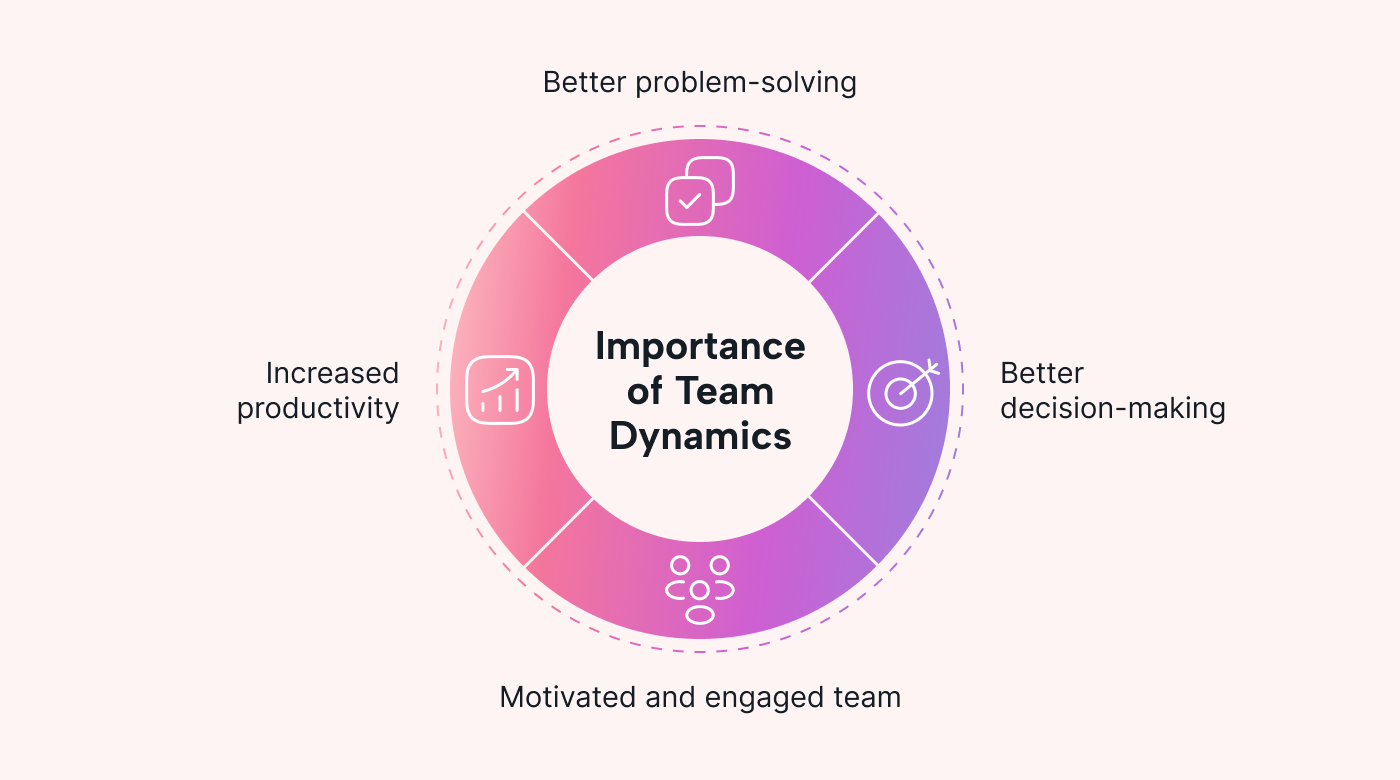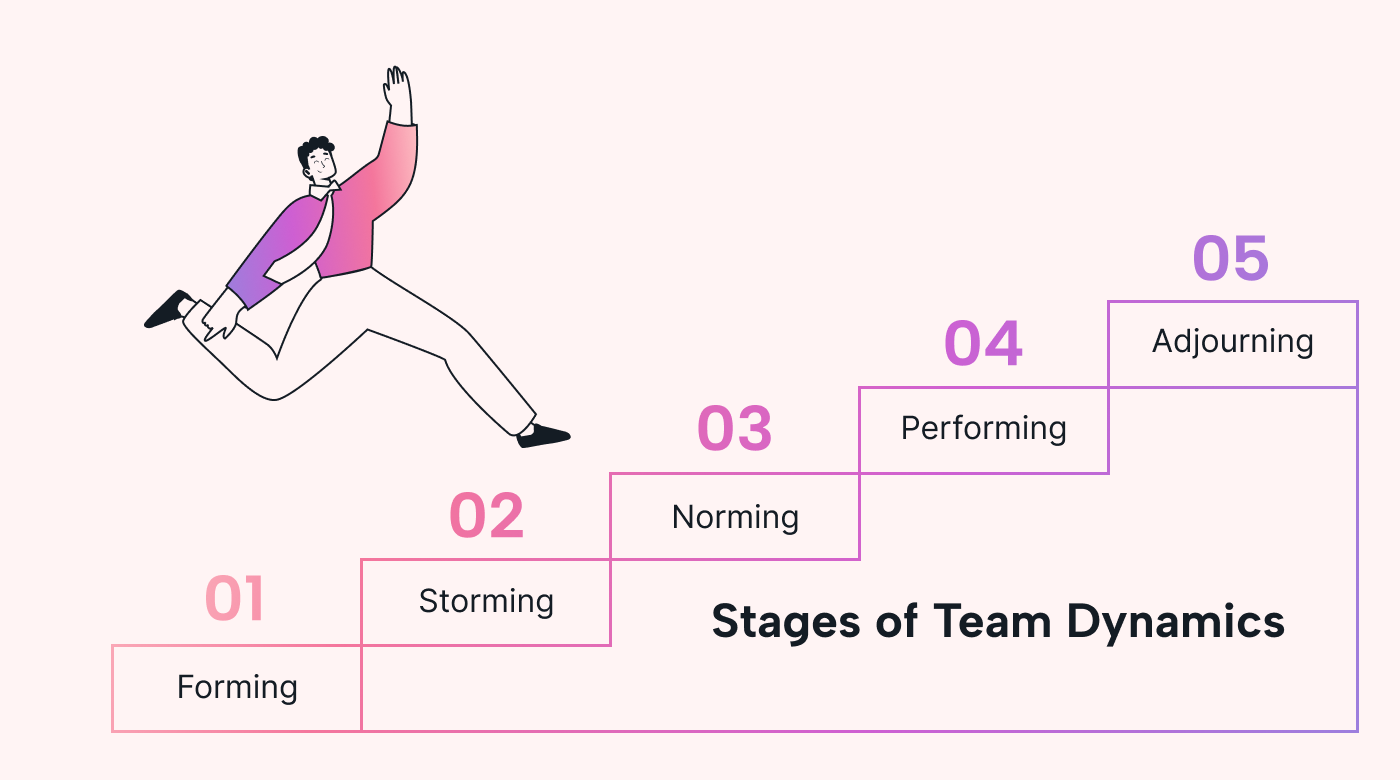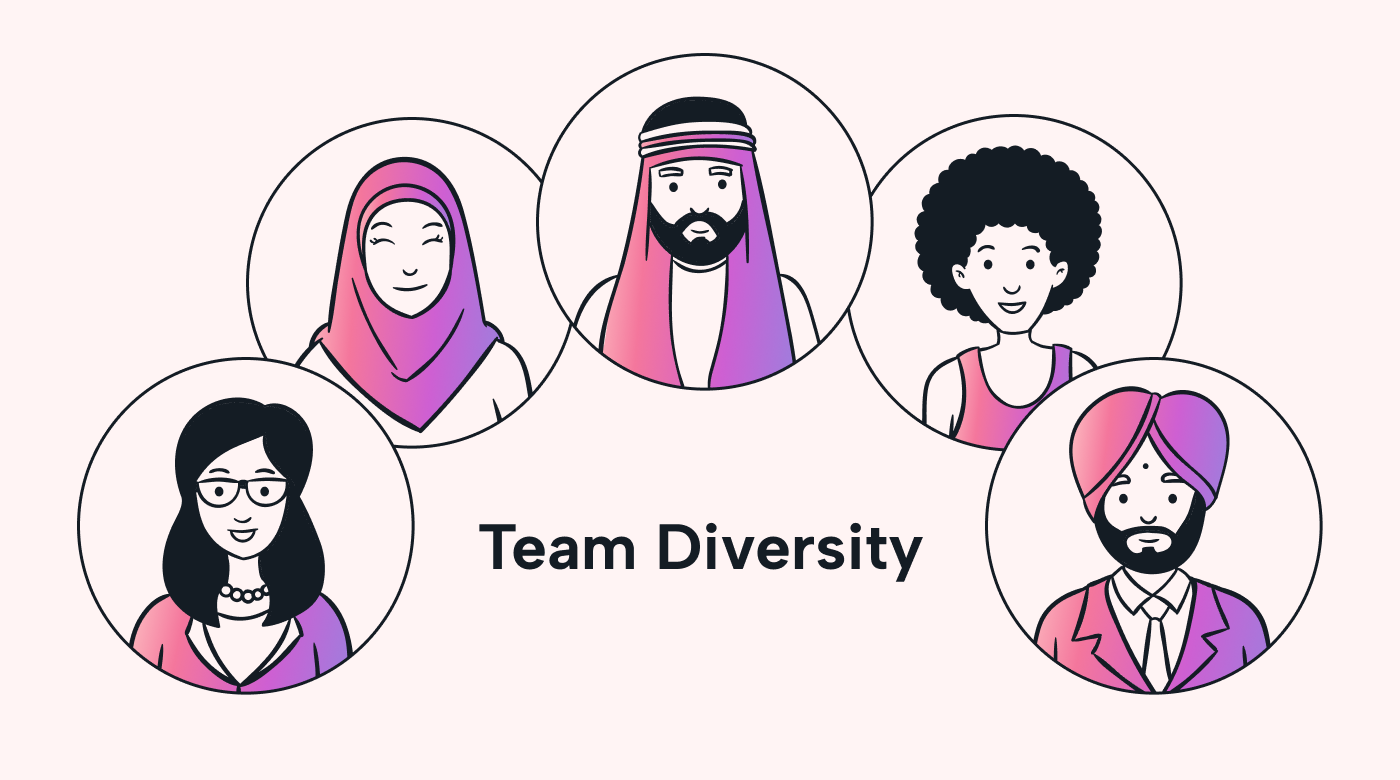An organization’s success relies heavily on its ability to foster effective teamwork. Teams are the building blocks of progress, with individuals coming together, pooling their unique skills and perspectives, and achieving collective greatness.
But what sets exceptional teams apart from the rest? The answer is team dynamics.
In this article, we explore what team dynamics means and its profound impact on productivity, innovation, and organizational achievement. We also provide practical insights and strategies for building and nurturing effective team dynamics within your own team.
What are team dynamics?
Team dynamics refer to how a group of people work together. It encompasses team members’ interactions, relationships, and patterns of behavior as they pursue a common goal.
Picture this: you're part of a group tasked with a creative project, but the dynamics among the team members are strained. Ideas clash, communication breaks down, and collaboration becomes an uphill battle. The atmosphere is tense, and the project suffers. Frustrating, right?
Now imagine the opposite scenario. You and your team members have a good rapport in an environment of trust, respect, and open communication. Ideas thrive, and productivity soars, helping your team tap into its collective potential. Each person contributes their unique talents, but the true magic lies in how the team works together as a cohesive unit.
Why are team dynamics important?
Here’s how positive team dynamics can contribute to a team’s success:
 |
Increased productivity
When you've got a team that just “clicks,” magic happens. Tasks are divided and conquered with ease, team members’ individual strengths are leveraged, and collaboration is effortless. This not only leads to better time management and task completion but also boosts overall productivity.
According to an article published in the Journal of Applied Behavioral Science, a workplace characterized by positive and virtuous practices excels in a number of domains. As author and world-renowned scholar Kim Cameron puts it, “When organizations institute positive, virtuous practices they achieve significantly higher levels of organizational effectiveness — including financial performance, customer satisfaction, and productivity.”
Better problem-solving
Positive team dynamics encourage diverse perspectives and ideas. When team members feel comfortable sharing their thoughts and opinions, comprehensive problem-solving and creative solutions result.
Improved decision-making
When your team members trust each other and aren't afraid to speak their minds, you're in for some informed, well-rounded decision-making. And with multiple viewpoints considered, potential risks identified, and consensus achieved through collaboration, the sky's the limit.
Motivated and engaged team
Positive team dynamics create an environment in which team members feel valued, supported, and motivated. When people are engaged in their work and have positive relationships with their teammates, they are more likely to be committed to the team's goals and go the extra mile.
5 stages of team dynamics
Great team rapport and cooperative dynamics don’t happen overnight. It takes time, effort, and patience for a group of people to establish relationships and transform into a collaborative team.
 |
Tuckman's Stages of Group Development is a widely accepted model for understanding group dynamics. This model describes five stages of group development: forming, storming, norming, performing, and adjourning. Let’s discuss each of them below.
1. Forming
In the forming stage, team members come together and get to know each other. They define their goals, roles, and responsibilities within the team. This stage often involves a sense of excitement and anticipation but also some uncertainty and caution.
2. Storming
During the storming stage, conflicts and differences of opinion may arise as team members start to assert themselves and voice their ideas. This stage can be challenging as the team navigates power dynamics, establishes positions, and resolves conflicts. Effective communication and conflict resolution skills are crucial during this stage.
3. Norming
In the norming stage, team members begin to establish norms, values, and expectations. They develop a sense of camaraderie and cooperation as they find ways to work together more smoothly. Roles and responsibilities become clearer, and mutual trust and respect start developing.
4. Performing
The performing stage is characterized by high levels of productivity and synergy. With the right productivity tools, team members can track and organize their tasks and projects.
Communication is open, deadlines are met, and the team works together almost seamlessly to produce high-quality work.
5. Adjourning
The adjourning stage, also known as the mourning or transforming stage, is when the team's project comes to an end. This stage focuses on reflection, celebrating achievements, and acknowledging the contributions of the team members.
It's important to note that these five stages are not always linear. Teams may move back and forth between them as they face new challenges or changes.
Examples of effective team dynamics
So what does a team with great dynamics look like? Let's dive deeper into some characteristics of teams that have great collaborative chemistry.
 |
Open communication
Open communication means team members actively listen to each other, showing genuine interest and respect for each other's ideas and opinions.
They create a safe and inclusive space where everyone feels comfortable expressing themselves, and they offer constructive feedback to one another.
Clear roles and responsibilities
Each team member knows what’s expected of them and how their contributions fit into the bigger picture. They acknowledge individual strengths and expertise and use them to improve the team's performance as a whole.
Workload and tasks are distributed fairly in a well-balanced team, with each member pulling their weight so that no one feels overwhelmed.
Trust and mutual respect
Team dynamics thrive when trust forms a solid foundation. Members actively support and celebrate each other's achievements while offering help when needed.
This leads to a safe environment where everyone feels valued and comfortable sharing ideas and taking risks, which leads to more motivation and engagement. In fact, 48% of employees cite respect as a top work-related motivation — on par with health benefits and work-life balance.
Diversity and inclusion
A great team celebrates and appreciates the unique qualities, backgrounds, perspectives, and experiences each member brings. They actively seek out different viewpoints and ideas, recognizing that this leads to better decision-making and problem-solving.
According to a 2021 CNBC|SurveyMonkey workforce survey, 78% of the workforce say they value working at an organization that prioritizes diversity and inclusion.
Effective leadership
Leaders guide and support the team, steering them toward success while encouraging them to make their own decisions. Motivated by their leaders' guidance, team members embrace challenges, persevere through obstacles, and achieve the team’s goals.
Flexibility and adaptability
A strong team is agile and embraces change, adapting to new circumstances and challenges as necessary. They have a growth mindset that sees the value in facing challenges rather than running away from them.
Strategies for enhancing team dynamics
Understanding the importance of team dynamics is just the first step to enhancing team dynamics. To really tap into a team’s potential, you need to actively encourage positive interactions.
Here are a few strategies for fostering positive team dynamics:
 |
Team-building activities
Team-building activities promote a strong bond among team members and encourage collective problem-solving. They can be anything from ice-breaker activities or outdoor games to workshops or retreats.
A classic example is the "Trust Fall" exercise, where a person falls backward, relying on the team member behind them to catch them. This simple yet fun activity encourages reliance on each other, builds trust, and creates a culture of psychological safety.
Clear and shared goals
Setting clear and shared goals helps align team members.
Start by clearly defining the purpose and mission of the team. What are you collectively striving to accomplish? Ensure that everyone understands and shares the same overarching objective.
Then, once the goal is achieved, celebrate as a team to boost morale, motivation, and a sense of accomplishment.
Regular feedback and evaluation
Encouraging ongoing feedback and open dialogue allows team members to provide input, share perspectives, and address concerns. This fosters a culture of continuous improvement and open communication within the team.
Team members and managers can identify what is working well and where adjustments are needed through regular evaluations. For example, a manager could set up weekly or bi-weekly one-on-one meetings with each team member to discuss their performance, provide feedback, and set goals for the next period.
Continuous learning and development
Leaders that promote a culture of learning foster an environment where members are encouraged to acquire new knowledge. And providing opportunities for professional growth, such as training programs, workshops, or conferences, enables teams to expand their skills and expertise.
According to LinkedIn’s 2023 Workplace Learning Report, 89% of learning and development professionals believe that improving employees’ skills will help them navigate the ever-changing future of work. Continuous learning basically sets up both the individual and the team for success.
Foster stronger team dynamics with Motion
Maintaining effective team dynamics can be challenging, but it's crucial for success. Two important pieces of the puzzle are open communication and task alignment. And Motion can help with both.
Motion for Teams can free up valuable time for tasks, allowing team members to focus on what really matters. With it, you can streamline your team's workflow, enhance communication, and celebrate victories together.
Start your free 7-day trial today and experience the power of efficient team dynamics firsthand.





